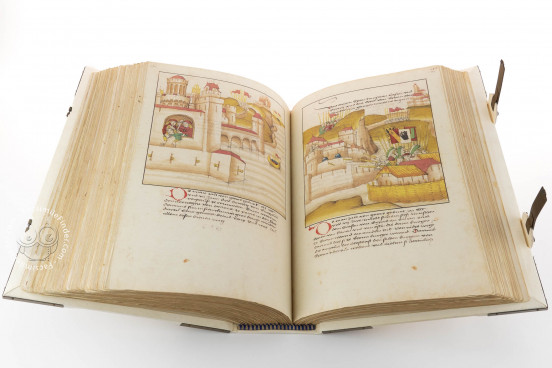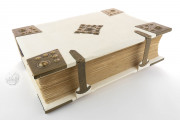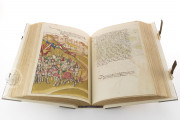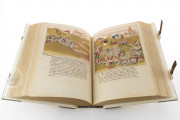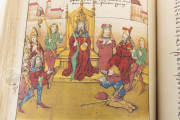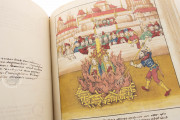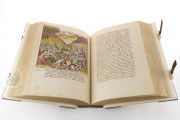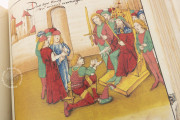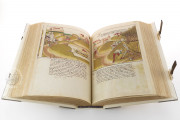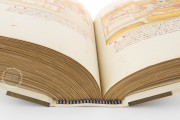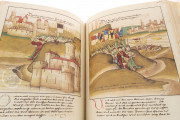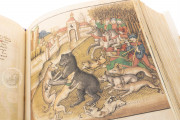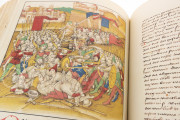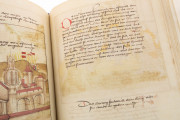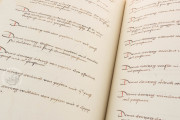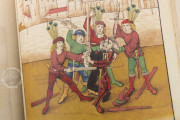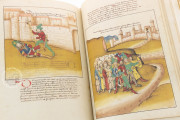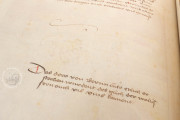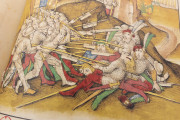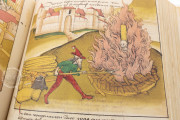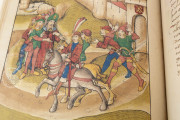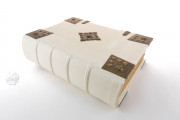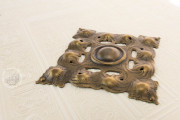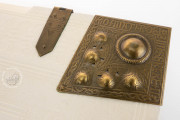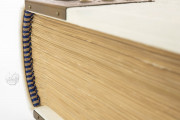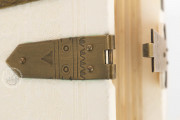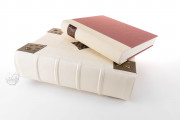The Lucerne Chronicle of Diebold Schilling from the year 1513 is considered the most beautiful of all illuminated chronicles ever made in the Swiss Confederation. It reflects the political, social, economic and religious life of a medieval town and of a whole country.
Chronicles as Important Works of the 15th and 16th Centuries
Expensively illuminated chronicles are typical of the late 15th century. In a number of cases they were made on the initiative of a prince, mostly though on commission of members of the ascending bourgeoisie in politically and economically prosperous cities.
The new wealth and self-confidence of the estates appeared not only in representative profane and ecclesiastical buildings but also in the edition of chronicles, aiming to preserve contemporary events in picture and word for posterity.
Of all chronicles, the Lucerne Chronicle is second to none, because of the wide range of medieval subjects depicted in this book. Its value resides mainly in the comprehensive presentation of life as it used to be at that time, in the perfect rendering of events by both illustrations and text.
The chronicle presents the political, social, economic and religious side of life in the late Middle Ages, thus providing a true mine of information for any historic discipline.
The Decoration of the Chronicle
The text is written in late medieval bastard script and of clearly less importance than the generously designed illustrations in opaque colours. These illustrations are somewhat special, in terms of number, style and execution.
In total, no less than 443 pages are decorated with miniatures, alternating between the upright, the oblong and the square format; there are also doublepage illustrations. The linear design, in black contours and painted in saturated colours, shows a truly overwhelming wealth of human figures, buildings and landscape motifs of any kind.
The pictorial impression is underlined by trompe-l’oeil frames in Gothic wooden profiles, tracery, banderoles, scrollwork and surrounding inscriptions. The text of the manuscript describes the history of the Swiss Confederation, from the beginnings until 1513.
It deals in particular with the recent history, i. e. the time between 1474 and 1513. Subjects range from the question of mercenaries, the relations of the Confederation with the bigger powers as well as with the emperor and the Empire.
Two Different Painters
Two painters participated in the artistic decoration of the work. Some pictures are ascribed to Diebold Schilling who uses a more naive, precise technique and strong colours. One can feel the influence of the Gothic style which marked late medieval miniature painting in its traditional form.
The second master has remained unknown. His illustrations are carried out in brighter colours. His brush painting is clearly more routine and is influenced by the Renaissance. In 1577, the manuscript was bound in a pigskin cover with toolings in the late Renaissance style.
The Master: Diebold Schilling
Born around 1460, Diebold Schilling inherited his motivation for his later artistic activity from his family. Both his father and his uncle of the same name (his uncle was the author of the famous Burgundian and Spiez Chronicles) had studied the art of writing in Lauber’s renowned workshop at Hagenau.
His uncle who had first worked as a clerk in the same position that would later be taken over by Diebold Schilling’s father, was the official annalist of the City Council of Bern. Diebold Schilling junior began to study canonic law in Basel and later in Padova.
From 1479 he was the official notary of Lucerne and prepared himself for a life in the clergy. However, he did not seem to be quite the right person for this kind of a career as he was repeatedly involved in trials for brawl and insult of honour.
Serving Two Masters
In 1497 he was appointed interpreter by an ambassador in Milan, and was later active as agent of the duke of Milan. For some time he worked in the services of the emperor Maximilian but soon changed to the court of the Sforza in Milan.
During this time, he wrote the chronicle, presumably on commission of the Lucerne authorities. In 1513, after several years of work, he presented the completed work to the City Council in a solemn session.
The first illustration of the chronicle depicts Fol. 132v/133. Left: View of Sitten; right: Werdenberg welcoming the landvogt of Lucerne. This memorable event. Diebold Schilling then disappears from the annals. No details are known about his death which has been dated to some time between 1515 and 1522.
We have 1 facsimile edition of the manuscript "Lucerne Chronicle of Diebold Schilling": Die Schweizer Bilderchronik des Luzerners Diebold Schilling facsimile edition, published by Faksimile Verlag, 1981
Request Info / Price
